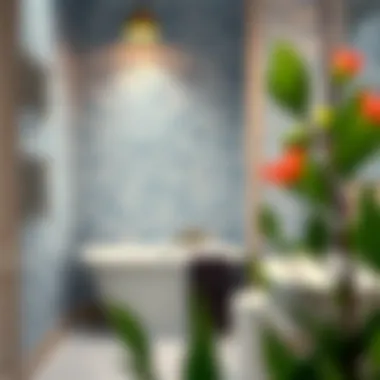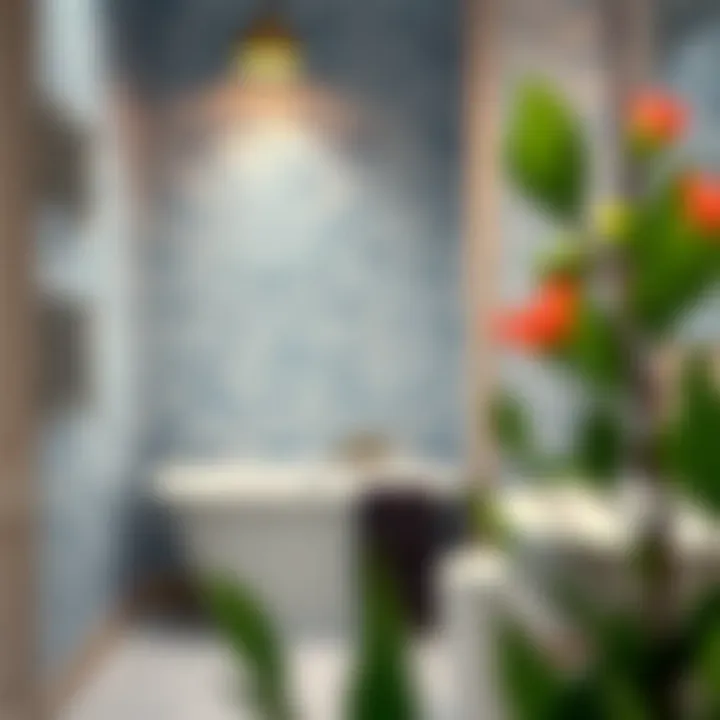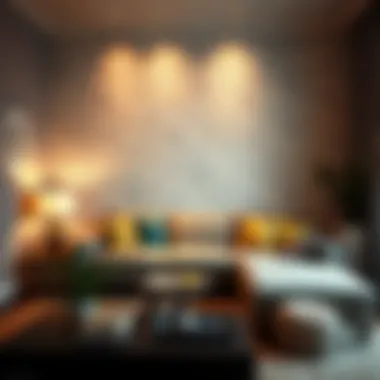Enhance Your Home with Subway Tile Peel and Stick Wallpaper


Intro
When it comes to sprucing up a space, subway tile peel and stick wallpaper stands out as a transformative choice for various reasons. Not only does it offer an easier way to achieve the timeless look of subway tiles, but it does so without the messy and expensive installation of traditional tiling. As this innovative product gains traction among design enthusiasts, understanding its aesthetic benefits and practical applications becomes crucial.
With a range of styles that cater to different tastes, from classic whites to more adventurous patterns, subway tile peel and stick wallpaper is not just a practical solution; it’s also a canvas for creativity. Whether you’re looking to revamp a kitchen backsplash, add flair to a bathroom, or create an accent wall in your living room, this versatile option can fit various environments and visual preferences.
As we delve deeper into the world of subway tile peel and stick wallpaper, we'll explore the latest fashion trends, the best materials available, maintenance tips, and much more. So grab a cup of coffee, and let’s embark on this detailed narrative about an exciting option for modern decor.
Preamble to Subway Tile Peel and Stick Wallpaper
Subway tile peel and stick wallpaper represents a fascinating intersection of practicality and aesthetic appeal, capturing the attention of homeowners and interior design enthusiasts alike. The surge in popularity can be attributed to the growing desire for stylish yet accessible home improvements. This innovation allows individuals to transform their spaces without the need for significant renovations or the investment of extensive time and resources.
As people increasingly seek to express their personal style within their homes, this type of wallpaper offers a unique solution by combining the classic look of traditional subway tiles with the straightforward application of modern wallpaper. One key factor to note is its adaptability; it's suitable for various settings, ranging from kitchens to bathrooms, and even accent walls in living areas. The ease of installation means that it caters perfectly to DIY aficionados, enabling them to achieve a designer look with just a bit of elbow grease and creativity.
Defining the Product
Subway tile peel and stick wallpaper is essentially a film-like product designed to mimic the classic glazed ceramic tiles that have graced urban subways for decades. This wallpaper is pre-pasted with an adhesive backing, which allows it to stick directly onto clean, smooth surfaces. The charm lies not just in its visual appeal but also in the convenience it offers. Homeowners can achieve the tile aesthetic without the commitment of actual tile installation.
These designs often come in various patterns and colors, allowing for further personal expression. From sleek white tiles to bold, colorful options that stand out, the choices are vast. It's worth noting that peel and stick wallpaper can be removed and repositioned, making it a fantastic option for those who like to change their interior decor frequently.
The Historical Context of Subway Tiles
The history of subway tiles dates back to the late 19th century when they were first used in New York’s subway system. Initially introduced for their durability and ease of cleaning, these tiles became iconic due to their simple yet timeless design. The gloss finish and rectangular shape became symbols of urban chic, finding their way into homes and commercial spaces globally over the years.
With the shift towards more modern and minimalistic home designs, subway tiles took on new life. They began to be seen not only as practical solutions but also as stylish décor options. As the trend grew, so did the emergence of alternative methods to achieve the subway look, culminating in the development of peel and stick wallpaper. This innovation honors the historical essence of subway tiles while bringing forth a contemporary application that aligns with current interior design trends.
"The marriage of historical elegance and modern convenience epitomizes the appeal of subway tile peel and stick wallpaper."
In summary, the advent of subway tile peel and stick wallpaper is rooted in a rich history, marrying aesthetic and modern practicality. By understanding its origin and evolution, one can appreciate the versatility and innovation this product brings to interior design.
Reasons to Choose Peel and Stick Wallpaper
When considering design options for your living space, subway tile peel and stick wallpaper emerges as a practical choice. This section shines a light on the various reasons one might lean towards this innovative product. We're not just talking about aesthetics here; it’s about the whole package: convenience, style, and accessibility.
Ease of Installation
One of the major perks of peel and stick wallpaper is how simple it is to slap on a wall. Unlike traditional tiling, which involves mortar, grout, and a level of labor that can make even the most patient individual pull their hair out, peel and stick wallpaper offers a merciful escape.
Preparation is minimal. Just make sure the wall is clean and dry, peel off the backing, and press it into place. It's like placing a sticker on a scrapbook page, but instead, you're beautifying your kitchen or bathroom! For those who may lack handyman skills, this method can seem like a breath of fresh air. It allows even the most reluctant DIYers to bring a little flair to their homes.
"A project that can be completed in an afternoon gives anyone the chance to transform their space without raising a sweat."
Versatility of Design
Subway tile peel and stick wallpaper is like the chameleon of home decor. The patterns and colors available make it suitable for any style, whether it be contemporary or classic. Imagine going for a sunny yellow tile look in the breakfast nook or a classic white herringbone for a more traditional dining space. The options genuinely are endless.
You can mix and match styles too! Creating a mosaic effect in different colors can be a fun afternoon project. Alternatively, maintaining a solid color creates a sleek backdrop for your decor items. Such adaptability means that you aren't confined to the same look year after year. Seasonal changes or evolving tastes can easily and affordably be accommodated.
Accessibility for DIY Projects
In a world where self-expression takes numerous forms, peeling and sticking wallpaper provides an approachable avenue for creativity. You don’t have to be a certified interior designer or a construction wizard to get started. This is a project that practically anyone can manage.
It sparks creativity. You can experiment without committing your entire budget—or your whole weekend—to the project. Why not throw in a splash of color for a quick facelift before hosting guests? Or revamp a child's playroom in a few hours? All it takes is some scissors, a smooth surface, and a little patience.
In addition, because the wallpaper is repositionable, you can test the waters without the pressure of long-term decision-making. If it doesn’t look right, just peel it off, and try again.
Ultimately, choosing subway tile peel and stick wallpaper is more than just about visuals. It's about experience—how it feels to create your space with ease and flexibility.
For further insights into the realm of wallpapers, consider visiting Wikipedia or Britannica for more detailed history and possible inspirations.
Design Aesthetics of Subway Tile Wallpaper


The visual appeal of subway tile peel and stick wallpaper holds significant weight in transforming spaces. It’s not just a decorative measure but a pivotal aspect that can define the ambiance of an area. When contemplating interior design, aesthetics play a crucial role, influencing mood and function. This section explores the various elements of design aesthetics, specifically focusing on two primary areas: color schemes and patterns, as well as textures and finishes. The right combination can elevate the space from mundane to magnificent.
Color Schemes and Patterns
Color sets the tone of any interior, and subway tile wallpaper provides ample options to explore. Traditional white subway tiles suggest a clean, minimalist look but designers can venture beyond this classic choice.
Consider rich navy blues or deep emerald greens to create a cozy feel. These hues can transform a kitchen nook into an inviting café-like space. Think about how color influences emotions; a soft pastel palette can evoke calmness while vibrant colors add energy to a room.
Moreover, patterns in subway tiles can provide artistry without overwhelming a space. For instance, a herringbone pattern can add a dash of sophistication, while a honeycomb design might inject some playfulness. Options are plentiful:
- Solid Colors: For a timeless appearance.
- Geometric Patterns: To introduce modern flair.
- Gradient or Ombre Effects: These can create depth and visual interest.
Marrying colors with patterns opens avenues for creativity. When choosing, consider the existing color palette and style of furniture to create unity. As one interior designer, Margaret Choi, noted, “The right color can breathe life into decor, and patterns can be the exclamation point.”
Textures and Finishes
The texture and finish of subway tile wallpaper are equally important, making a design feel complete. A glossy finish can impart a sleek, polished look, which can make small spaces appear larger and more open. On the contrary, a matte finish might create a more subdued and relaxed atmosphere. This contrast is subtle yet powerful — the choice here hinges on the desired aesthetic.
Different textures can mimic the feel of real tiles, offering a tactile experience that’s delightful without the heavyweight hassle of traditional tiles. Consider embossed finishes that create shadows and highlights, adding dimensionality to flat surfaces. This isn’t merely a visual game; the feel also plays a part, potentially impacting how occupants interact with their space.
There’s a growing trend towards combining textures and finishes. For example, a satin finish could work well with a raised pattern, striking a balance between artistry and sophistication.
"The best designs are those that engage the senses; texture is as crucial as color in achieving this goal."
– Samira Peters, Interior Design Specialist
By carefully selecting color schemes, patterns, textures, and finishes, one can create not only visually appealing spaces but also environments that resonate with personal style and functional needs. The aesthetic considerations of subway tile peel and stick wallpaper are numerous and can influence the overall design narrative of a home.
Practical Considerations
When considering subway tile peel and stick wallpaper, practical aspects play a fundamental role in determining its suitability for your specific needs. These considerations encompass crucial elements that can impact the longevity, aesthetics, and overall success of your interior design project. By understanding these facets, you can make a well-informed decision on whether this innovative product fits your home.
Surface Preparation and Adhesion
Before applying peel and stick wallpaper, surface preparation is the crux. A properly prepared surface enhances adhesion, ensuring the wallpaper stays firm and looks its best for years to come. Experts suggest cleaning the wall thoroughly to remove any dirt, grease, or dust. A quick wipe with a mixture of warm water and mild soap often does the trick. If your walls are painted, ensure that the paint is completely dry and hasn't seen any recent touch-ups, as moisture can undermine adhesion.
Once the wall is prepped, you might want to consider patching up any imperfections, such as holes or cracks. You don’t need a pristine surface, but minor flaws that could show through should be remedied. It might sound a tad tedious, but think of it this way: investing a bit of time in surface prep can save you from a sticky situation down the line.
Adhesion properties can also vary between different brands of wallpaper, so it’s worth checking manufacturer recommendations. A few common tips here could include:
- Test a small area first to see how well the wallpaper adheres.
- Temperature matters; adhering in a controlled, moderate climate typically yields better results.
"Preparation is key to a successful finish. A stitch in time saves nine."—wise words to live by when decorating.
Durability and Wear Resistance
When it comes to durability, subway tile peel and stick wallpaper stands out among temporary solutions. Many iterations of this wallpaper feature robust materials, often vinyl, that resist moisture, stains, and fading. This factor is especially vital in high-traffic areas such as kitchens and bathrooms, where moisture can wreak havoc on lesser products.
However, not all peel and stick wallpaper is created equal. Always look for options labeled as water-resistant or washable. Regular cleaning might be necessary, but it's important to follow the manufacturer’s guidelines. Using harsh chemicals can damage the wallpaper's surface and affect longevity. A gentle cleaner applied with a soft cloth works wonders without risking the integrity of your design.
Let's break down some key considerations for durability:
- Wear and Tear: Higher durability ratings will often translate into a more resilient wallpaper. Look for reviews and real-world performance statements from other users.
- Maintenance: Ease of maintenance can enhance the longevity of your installation. Is it easy to clean? Can it hold up against the trials of daily life?
- Environmental Factors: If your space experiences substantial humidity fluctuations, consider wallpapers designed specifically to handle such conditions efficiently. They tend to boast enhanced adhesion and resistance to peeling.
In summation, diving deeper into practical considerations not only elevates your immediate project but also ensures that you’re investing wisely in your space. Subway tile peel and stick wallpaper can offer the perfect balance of aesthetics and utility when approached with the right knowledge.
Installation Techniques
When considering subway tile peel and stick wallpaper, understanding the installation techniques is essential for achieving an appealing finish. This kind of wallpaper offers novelties in design along with practical benefits, making it a popular choice among homeowners and designers alike. The ease of installation is one of its major selling points, which can turn even the most hesitant DIYer into a confident creator.
Why It Matters: The installation process sets the stage for how your new wall covering will ultimately perform and look. A solid installation will result in a seamless, attractive, and durable surface, while a slipshod job might lead to peeling or bubbles that detract from aesthetic appeal. Thus, taking careful measures from the get-go can save a world of trouble later.
Tools and Materials Required
Before you dive in, it’s crucial to gather the right tools and materials to facilitate a smooth installation process. Here’s what you’ll need:
- Subway Tile Peel and Stick Wallpaper: Choose your design wisely; it’s the star of the show.
- Cutting Tools: A utility knife or scissors to trim excess wallpaper. Precision is key here.
- Measuring Tape: This will assist in cutting the wallpaper to the correct dimensions.
- Level: Ensures your application is straight — slanted tiles can ruin the visual harmony.
- Smoothing Tool: Often a plastic smoother works well to apply pressure and expel air bubbles.
- Ruler or Straight Edge: Helps in achieving straight cuts and maintaining lines.
- Cleaning Supplies: A mild cleaner or simply soap and water to prepare your walls before application.


Having everything handy prevents those annoying stops and starts during the installation. This ensures that the process remains fluid and efficient.
Step-by-Step Installation Guide
Following proper steps will lead to a successful installation of your subway tile peel and stick wallpaper. Here’s a straightforward guide to help you navigate:
- Prepare the Wall Surface: Start by cleaning the wall thoroughly. Remove any dust, grease, or grime that could hinder adhesion. Ensure the surface is dry and smooth; otherwise, the wallpaper might not stick properly.
- Measure and Cut the Wallpaper: Measure the height and width of the area where you’ll be installing. Cut the wallpaper into strips, making sure to leave a bit extra at each end for adjustments.
- Position the First Strip: Align the top of the strip with your marked line, using the level to ensure it's straight. Slowly peel the backing, working your way down while smoothing the wallpaper onto the wall, pressing firmly to combat air bubbles.
- Smooth Out Air Bubbles: As you apply each new strip, use a smoothing tool to push any bubbles from the center outwards towards the edges. If a bubble is particularly stubborn, you can puncture it gently with a pin and smooth it out again.
- Trim Excess Wallpaper: Once all strips are hung, carefully use the utility knife to trim any excess wallpaper at the seams or edge. This step requires precision, so take it slow to avoid cutting too deep.
- Final Checks: Walk around the area and inspect your work. Make sure everything looks as it should, and touch up any areas that may need a bit of extra smoothing.
"The quickest way to make a home feel brand new is through the right choice of wallpaper. It transforms the space instantly."
By following these steps, you can ensure a polished look that rivals any traditional tiling job. Remember, a patient approach will yield the best results, so take your time and enjoy the transformation of your space.
Maintenance and Care for Peel and Stick Wallpaper
Caring for your peel and stick wallpaper might not be the first thing that jumps to the forefront of one’s mind, but it plays a vital role in its longevity and aesthetic appeal. After all, maintaining the look of your interior spaces is as significant as the initial design choice. It’s a no-brainer that regular upkeep can extend the life of your wallpaper while keeping it looking fresh and vibrant.
Benefits of Maintenance
Investing time into caring for your peel and stick wallpaper yields multiple benefits that enhance everyday living. Regular cleaning can prevent dirt buildup, which can cause discoloration or a dull appearance over time. Equally, taking a proactive approach to repairs can save you from potential costs down the road. With a few simple measures, you could easily maintain the allure of your interior spaces without compromising on style.
Cleaning Methods
Keeping your wallpaper clean doesn’t have to be an arduous task. In fact, it's quite straightforward. Most peel and stick wallpaper can be cleaned using simple household products. Here’s a step-by-step guide to ensure your installation remains in tip-top shape:
- Dusting: Use a soft, dry cloth or a feather duster to remove any dust or debris. Aim for a light touch to avoid tearing or damaging the surface.
- Spot Cleaning: For stains, a gentle mixture of warm water and mild soap will do the trick. Grab a soft sponge, dip it in the solution, and wring it out so it’s not dripping wet. A quick dab over the stain should suffice.
- Avoid Harsh Chemicals: Stay clear of ammonia, bleach or any abrasive cleaners. They can strip the wallpaper and potentially fade the color or finish.
- Drying: Once you've cleaned with a damp cloth, follow up with a dry one to absorb any excess moisture. This helps in avoiding water damage and keeps the wallpaper looking sharp.
"An ounce of prevention is worth a pound of cure; keeping it clean early on saves a headache later."
Repairing and Replacing Sections
Despite your best efforts, accidents can happen. The beauty of peel and stick wallpaper lies in its accessibility to repairs. Should a particular section become damaged, there’s no need to fret—replacement is a breeze. Here’s how:
Identifying Damage
It’s crucial to inspect your wallpaper for any indications of wear. Look out for:
- Peeling edges: This could happen in high-traffic areas or around moisture-prone spots, like kitchen backsplashes.
- Tears or scratches: Furniture, pets, or mishaps can lead to physical damage.
Replacement Steps
- Remove the Damaged Section: Carefully peel back the wallpaper at the damaged area. If it’s stuck on tightly, use a hairdryer on a low setting to loosen the adhesive.
- Measure for New Piece: Use a measuring tape to ascertain the dimensions of the area requiring replacement. Cut a new section accordingly, ensuring that the design matches the existing layout.
- Reapply: Align the new piece carefully, ensuring it adheres smoothly. Gently press to remove air bubbles, running your hand down from the top to the bottom.
Long-Term Considerations
It might also be wise to keep a spare roll handy, especially if you have a design that’s particularly unique or if the initial product is likely to be phased out. Sourcing extra pieces soon after installation can spare you from future mismatched designs or discontinuation issues.
In short, maintenance and care for peel and stick wallpaper may seem trivial, but it’s the small efforts that lead to standing the test of time. Keeping everything clean and being prepared to tackle repairs means you’ll be able to enjoy your beautifully designed space for years to come.
Environmental Impact and Sustainability
Considering the environmental impact of home decor choices has become more essential than ever. Subway tile peel and stick wallpaper stands out as a more sustainable option compared to traditional tile installations, primarily due to its unique materials and production processes. As the world becomes increasingly aware of environmental issues, integrating sustainable practices into our homes is no longer just a trend, but a necessity for many conscientious consumers.
Materials and Sourcing
When you look closer at the materials used in subway tile peel and stick wallpaper, you often find that many brands prioritize eco-friendliness. This could include the use of vinyl that is free from harmful substances such as phthalates or lead. It is advisable to look for products that have the Green Seal or FSC certification. These labels indicate responsibly sourced materials, ensuring that the production process has minimal impact on forests and ecosystems.
Moreover, many manufacturers are transitioning to processes that reduce waste. For instance, utilizing low-emission inks during printing not only yields vibrant designs but also lessens the toxic fallout often associated with home decor products. As a homeowner, choosing these eco-conscious options means that you’re not just beautifying your living space, you’re also making a commitment to sustainability.
Recycling and Disposal Options
Like all home decor products, when you decide to retire your peel and stick wallpaper, the way you dispose of it can say a lot about your commitment to sustainability. Fortunately, many peel and stick wallpapers can be disposable in an environmentally friendly manner. It’s important to check whether your specific product is recyclable or compostable. For instance, some brands allow you to return old wallpaper rolls for recycling, thus promoting a circular economy.
If recycling isn't feasible, then consider other disposal options. Properly disposing of materials in local waste management programs can mitigate the impact on landfills. Additionally, some creative DIY enthusiasts repurpose old wallpaper for various projects, like crafting or even creating art, thus prolonging the life of the materials instead of relegating them to the trash pile.


"Choosing sustainable options is not only an act of responsibility but also an investment in the future of our planet."
By being vigilant about materials used and by exploring recycling options, homeowners can contribute positively to both their space and their community. In doing so, using subway tile peel and stick wallpaper becomes much more than just a decorating choice; it becomes a conscious decision toward sustainability.
Comparative Analysis with Traditional Tiling
When it comes to enhancing the aesthetic appeal of spaces, the debate between subway tile peel and stick wallpaper and traditional tiling is ever-present. Each option holds its own merits and drawbacks. Understanding this comparative analysis is not just about preference; it’s critical for making informed decisions that align with both aesthetic desires and practical needs. The rise of peel and stick wallpaper has its roots in a desire for simpler, more user-friendly alternatives to traditional tiling. With this in mind, we will examine essential elements like cost, installation, and the subjective aspects like style and usability.
Cost-Benefit Assessment
Let’s face it, remodeling can drain your wallet quicker than a fast-food drive-thru when you’re not paying attention. Traditional tiling isn’t just a physical commitment—it’s also a financial one. The expenses don’t stop at the tiles themselves; there are costs for cement boards, adhesives, and professional installation, not to mention the time it takes, which many often underestimate. On the flip side, subway tile peel and stick wallpaper is designed with affordability in mind. Here are some key points to consider:
- Initial Costs: Peel and stick wallpaper typically costs a fraction of traditional tiles. For instance, while high-end subway tiles can run you upwards of $15-$25 per square foot, peel and stick options hover around $2-$5.
- Installation Costs: Traditional tiling often requires professional help, which can double or even triple your expenditure. Peel and stick offers a viable DIY approach, placing the power back in your hands and saving you that hard-earned cash.
- Long-Term Costs: It’s worthwhile to consider maintenance and potential repair costs. Traditional tiles may crack, chip, or become outdated, requiring replacement. Conversely, if your peel and stick wallpaper gets damaged, it often only means swapping out a section rather than an entire surface.
Longevity and Resale Value
Here’s where the rubber meets the road—how does each one stand against the test of time? Longevity and resale value significantly contribute to the overall worth of your home.
- Durability: Traditional tiles are undoubtedly sturdier and more resistant to moisture and wear. However, a well-installed subway tile peel and stick can hold its own in low-moisture areas, making it an attractive option for DIY enthusiasts looking to uplift their space without too much hassle.
- Resale Value: Real estate trends show that some potential buyers appreciate classic finishes like traditional tiling, which can add value to your home. Still, an impeccably applied peel and stick wallpaper can wow home inspectors and buyers alike, especially if it’s styled beautifully. If you use high-quality wallpaper designs that mimic authentic tile looks, you could find yourself maintaining good resale value without the heavy labor.
"In the quest for beauty and functionality, finding the right balance between cost and quality can be more important than the materials themselves."
In essence, both subway tile peel and stick wallpaper and traditional tiles offer unique advantages. It invariably comes down to factors like budget, personal preference, and future considerations. By understanding these comparisons, homeowners can strategically navigate their renovation projects without losing their sense of style—or their savings.
User Experiences and Case Studies
When it comes to decorating a space, firsthand accounts can offer invaluable insights. User experiences and case studies are crucial in this article because they not only illustrate the practical benefits of subway tile peel and stick wallpaper but also highlight the diverse applications of the product in real-life settings. These narratives provide a relatable touchpoint for readers considering a similar transformation in their own homes. By looking at how different individuals and professionals have utilized this wallpaper, we can better appreciate its potential and the challenges that might arise.
Homeowners are often faced with a myriad of choices in decor. The journey to a well-curated interior typically involves a lot of trial and error. This section seeks to streamline that process by curating qualitative feedback and case studies, thus allowing readers to absorb practical wisdom from diverse perspectives.
Testimonials from Homeowners
Homeowners have embraced subway tile peel and stick wallpaper for various reasons, and their testimonials often reflect a blend of practicality and aesthetic appeal. Consider Clara, a young mother from Denver. Her kitchen was previously dull and uninspired. After using a brick-patterned peel and stick wallpaper, she noted not just the aesthetic uplift but also how easy it was to clean after her kids' culinary adventures. "It feels like I have a new kitchen without a major overhaul," she remarked.
Another homeowner, Raj, shared his experience of using this wallpaper in his bathroom. He described how the sleek subway tile design lent a touch of elegance while being functional enough to withstand the humid environment. Many homeowners echo a common sentiment: the ease of installation allowed them to undertake projects they previously wouldn't have considered. This DIY-friendly approach can be attractive for those looking to save money while enhancing their environments.
"Transforming my space was never this fuss-free! It's like I painted, but with so much more character," said Linda, who successfully added subway tile wallpaper to her laundry room.
These testimonials not only highlight the product's advantages but create a narrative that blends personal experience with practical advice. Homeowners uniformly stress that the wallpaper’s adhesion to various surfaces is usually trouble-free, leading to a reliable finish that doesn’t compromise on style.
Case Studies from Interior Designers
Interior designers frequently turn to peel and stick wallpaper for its versatility. In a recent project, designer Mia Chen integrated subway tile wallpaper into a compact apartment kitchen. She opted for a textured white subway tile look, emphasizing how it added depth without overwhelming the space. The homeowner was skeptical at first, but Mia’s vision and the tangible changes solidified her trust in the process. "After installation, it not only opened up the room but also made it feel much more inviting," Mia commented during a design showcase.
Moreover, the case study of a restaurant revamp in Boston illustrated the commercial application of subway tile wallpaper. The designer, Jake Martinez, explored a matte black tile pattern to create a striking focal point. Not only did it stand up to heavy use, but it also became a talking point with patrons. The efficiency of application during a tight renovation timeline showcased how these materials cater well to fast-paced environments.
Through these experiences, it's evident that subway tile peel and stick wallpaper isn't confined to residential use. Designers are employing it creatively in various commercial arenas, proving its adaptability and relevance across sectors.
Future Trends in Wallpaper Innovations
As the home decor landscape continues to evolve, understanding the future trends in wallpaper innovations becomes increasingly essential. This section will delve into the transformative aspects of wallpaper, particularly focusing on subway tile peel and stick varieties. Technology and design are merging in ways that not only enhance aesthetic appeal but also improve functionality and usability. By familiarizing ourselves with these emerging trends, fashion enthusiasts and industry professionals alike can stay ahead of the curve, making informed decisions for their projects.
Integration of Smart Technologies
The rise of smart home technologies is reshaping various domains, and wallpaper is no exception. Innovations are being introduced that integrate digital functionality right into wallpaper design. Imagine a world where your wallpaper can change color based on your mood or the time of day. With sensors embedded in peel and stick wallpaper, users can customize their surroundings effortlessly.
- Smart Lighting Integration: Some wallpapers are combined with LED lights, responding to smart home systems to shift hues or brightness, thus entirely altering the room's ambience with just a command.
- Sustainability Tracking: Innovative wallpapers are being designed with materials that can indicate environmental impact, promoting sustainability awareness among homeowners.
The possibilities these technologies provide are game-changers. By making interior design interactive, consumers have a chance at personalization like never before. Such integration places subway tile peel and stick wallpaper at the forefront of design innovation, addressing both aesthetic and practical home requirements.
Evolving Design Trends
Design trends in wallpaper are shifting dramatically in response to changing consumer tastes and technological advancements. The subway tile pattern remains timeless, but how it is utilized is definitely changing.
- Mix and Match Patterns: Today’s designers are encouraged to blend subway tile peel and stick wallpaper with various textures and styles. Ideas include pairing them with bold florals or geometric shapes for a high-impact visual. This approach not only queries traditional choices but also celebrates diversity in design.
- Textural Depth: Wallpaper that mimics textures like wood, stone, or fabric is trending. This method introduces layers into spaces, adding complexity in simple peel and stick formats, while still being easy to install and maintain.
- Color Adaptability: The color palette for subway tile wallpaper is expanding, with darker, moodier tones gaining popularity. This trend indicates a shift toward creating bolder and more intimate spaces.
"Evolving design trends reflect a deeper understanding of the psychological impacts of color and texture, urging consumers to explore layers in their interiors."
In summary, the future of wallpaper, especially in the context of subway tile peel and stick styles, is dynamic and continually adapting. Staying aware of these trends offers invaluable insights for anyone looking to make a statement or innovate within their spaces.







